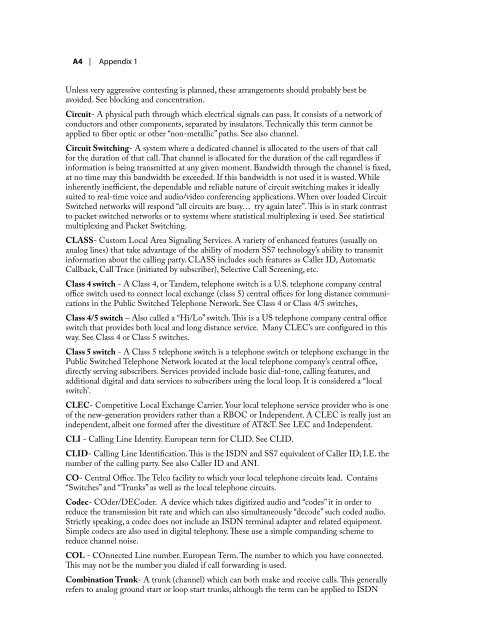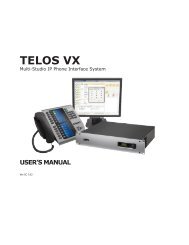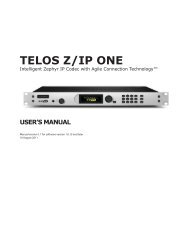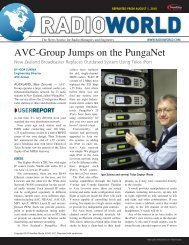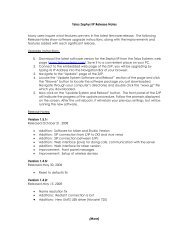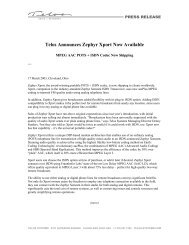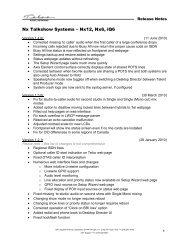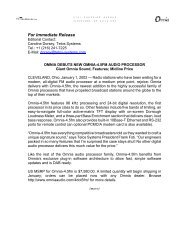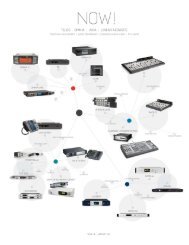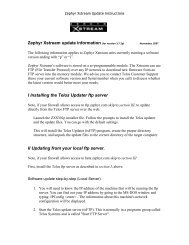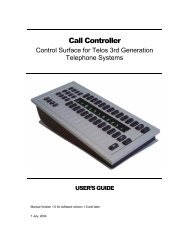Hx1-Hx2 Manual-1.4.1 - Telos
Hx1-Hx2 Manual-1.4.1 - Telos
Hx1-Hx2 Manual-1.4.1 - Telos
Create successful ePaper yourself
Turn your PDF publications into a flip-book with our unique Google optimized e-Paper software.
A4 | appendix 1<br />
Unless very aggressive contesting is planned, these arrangements should probably best be<br />
avoided. See blocking and concentration.<br />
Circuit- A physical path through which electrical signals can pass. It consists of a network of<br />
conductors and other components, separated by insulators. Technically this term cannot be<br />
applied to fiber optic or other “non-metallic” paths. See also channel.<br />
Circuit Switching- A system where a dedicated channel is allocated to the users of that call<br />
for the duration of that call. That channel is allocated for the duration of the call regardless if<br />
information is being transmitted at any given moment. Bandwidth through the channel is fixed,<br />
at no time may this bandwidth be exceeded. If this bandwidth is not used it is wasted. While<br />
inherently inefficient, the dependable and reliable nature of circuit switching makes it ideally<br />
suited to real-time voice and audio/video conferencing applications. When over loaded Circuit<br />
Switched networks will respond “all circuits are busy… try again later”. This is in stark contrast<br />
to packet switched networks or to systems where statistical multiplexing is used. See statistical<br />
multiplexing and Packet Switching.<br />
CLASS- Custom Local Area Signaling Services. A variety of enhanced features (usually on<br />
analog lines) that take advantage of the ability of modern SS7 technology’s ability to transmit<br />
information about the calling party. CLASS includes such features as Caller ID, Automatic<br />
Callback, Call Trace (initiated by subscriber), Selective Call Screening, etc.<br />
Class 4 switch - A Class 4, or Tandem, telephone switch is a U.S. telephone company central<br />
office switch used to connect local exchange (class 5) central offices for long distance communications<br />
in the Public Switched Telephone Network. See Class 4 or Class 4/5 switches,<br />
Class 4/5 switch – Also called a “Hi/Lo” switch. This is a US telephone company central office<br />
switch that provides both local and long distance service. Many CLEC’s are configured in this<br />
way. See Class 4 or Class 5 switches.<br />
Class 5 switch - A Class 5 telephone switch is a telephone switch or telephone exchange in the<br />
Public Switched Telephone Network located at the local telephone company’s central office,<br />
directly serving subscribers. Services provided include basic dial-tone, calling features, and<br />
additional digital and data services to subscribers using the local loop. It is considered a “local<br />
switch’.<br />
CLEC- Competitive Local Exchange Carrier. Your local telephone service provider who is one<br />
of the new-generation providers rather than a RBOC or Independent. A CLEC is really just an<br />
independent, albeit one formed after the divestiture of AT&T. See LEC and Independent.<br />
CLI - Calling Line Identity. European term for CLID. See CLID.<br />
CLID- Calling Line Identification. This is the ISDN and SS7 equivalent of Caller ID; I.E. the<br />
number of the calling party. See also Caller ID and ANI.<br />
CO- Central Office. The Telco facility to which your local telephone circuits lead. Contains<br />
“Switches” and “Trunks” as well as the local telephone circuits.<br />
Codec- COder/DECoder. A device which takes digitized audio and “codes” it in order to<br />
reduce the transmission bit rate and which can also simultaneously “decode” such coded audio.<br />
Strictly speaking, a codec does not include an ISDN terminal adapter and related equipment.<br />
Simple codecs are also used in digital telephony. These use a simple companding scheme to<br />
reduce channel noise.<br />
COL - COnnected Line number. European Term. The number to which you have connected.<br />
This may not be the number you dialed if call forwarding is used.<br />
Combination Trunk- A trunk (channel) which can both make and receive calls. This generally<br />
refers to analog ground start or loop start trunks, although the term can be applied to ISDN


